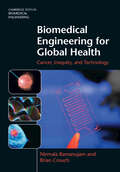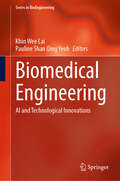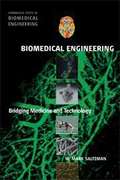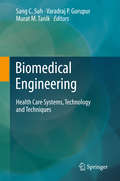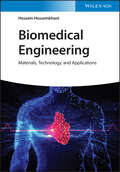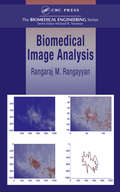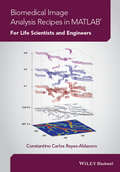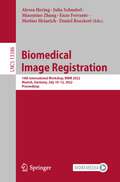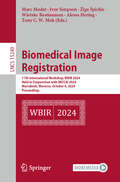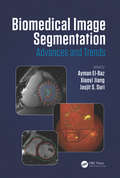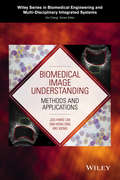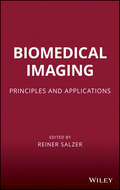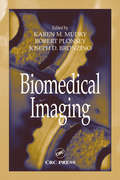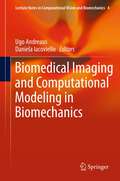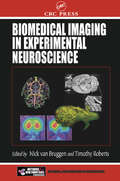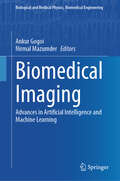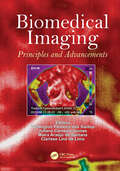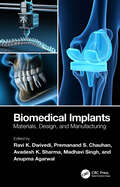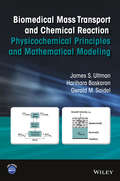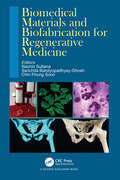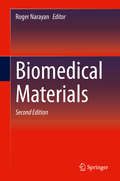- Table View
- List View
Biomedical Engineering and its Applications in Healthcare
by Sudip PaulThis book illustrates the significance of biomedical engineering in modern healthcare systems. Biomedical engineering plays an important role in a range of areas, from diagnosis and analysis to treatment and recovery and has entered the public consciousness through the proliferation of implantable medical devices, such as pacemakers and artificial hips, as well as the more futuristic technologies such as stem cell engineering and 3-D printing of biological organs. Starting with an introduction to biomedical engineering, the book then discusses various tools and techniques for medical diagnostics and treatment and recent advances. It also provides comprehensive and integrated information on rehabilitation engineering, including the design of artificial body parts, and the underlying principles, and standards. It also presents a conceptual framework to clarify the relationship between ethical policies in medical practice and philosophical moral reasoning. Lastly, the book highlights a number of challenges associated with modern healthcare technologies.
Biomedical Engineering for Global Health
by Rebecca Richards-KortumCan technology and innovation transform world health? Connecting undergraduate students with global problems, Rebecca Richard-Kortum examines the interplay between biomedical technology design and the medical, regulatory, economic, social and ethical issues surrounding global health. Driven by case studies, including cancer screening, imaging technologies, implantable devices and vaccines, students learn how the complexities and variation across the globe affect the design of devices and therapies. A wealth of learning features, including classroom activities, project assignments, homework problems and weblinks within the book and online, provide a full teaching package. For visionary general science and biomedical engineering courses, this book will inspire students to engage in solving global issues that face us all.
Biomedical Engineering for Global Health: Cancer, Inequity, and Technology (Cambridge Texts in Biomedical Engineering)
by Nirmala Ramanujam Brian CrouchExplore the fundamentals of biomedical engineering technologies with this thought-provoking introduction, framed around modern-day global cancer inequities. Connecting engineering principles to real-world global health scenarios, this textbook introduces major technological advances in cancer care through the lens of global health inequity, discusses how promising new technologies can address this inequity, and demonstrates how novel medical technologies are adopted for real-world clinical use. It includes modular chapters designed to enable a flexible pathway through material, for students from a wide range of backgrounds; boxed discussion of contemporary issues in engineering for global health, encouraging students to explore ethical questions related to science and society; supplementary lab modules for hands-on experience in translating engineering principles into healthcare solutions; and over 200 end-of-chapter problems, targeting multiple learning outcomes to solidify student understanding. This introduction is designed to equip students with all the critical, technical, and ethical knowledge they need to excel.
Biomedical Engineering: AI and Technological Innovations (Series in BioEngineering)
by Khin Wee Lai Pauline Shan Qing YeohThis book brings together contributions from leading experts in the field, each addressing a critical area where AI and technology are making significant impacts. The chapters encompass a wide range of topics, from the application of machine learning in cancer grading and maternal health monitoring to the development of innovative wearable devices and advanced diagnostic tools. The book not only underscores the transformative potential of AI and technology in biomedical; but also serves as a vital resource for researchers, practitioners, and students. By showcasing the latest research and innovations, this book aims to inspire continued exploration and development in this dynamic and rapidly evolving field.
Biomedical Engineering: Bridging Medicine and Technology
by W. Mark SaltzmanThis book is an introduction to biomedical engineering, starting from the basics and demonstrating the engineering principles that are used to create new diagnostic methods and therapies for human disease. Although biomedical engineering is a relatively new field of study, it will impact almost every person in the world.
Biomedical Engineering: Health Care Systems, Technology and Techniques
by Sang C. Suh Varadraj Gurupur Murat M. TanikBiomedical Engineering: Health Care Systems, Technology and Techniques is an edited volume with contributions from world experts. It provides readers with unique contributions related to current research and future healthcare systems. Practitioners and researchers focused on computer science, bioinformatics, engineering and medicine will find this book a valuable reference.
Biomedical Engineering: Materials, Technology, and Applications
by Hossein HosseinkhaniBiomedical Engineering An exploration of materials processing and engineering technology across a wide range of medical applications The field of biomedical engineering has played a vital role in the progression of medical development technology. Biomedical Engineering: Materials, Technology, and Applications covers key aspects of the field—from basic concepts to advanced level research for medical applications. The book stands as a source of inspiration for research on materials as well as their development and practical application within specialized industries. It begins with a discussion of what biomedical engineering is and concludes with a final chapter on the advancements of biomaterials technology in medicine. Offers comprehensive coverage of topics, including biomaterials, tissue engineering, bioreceptor interactions, and various medical applications Discusses applications in critical industries such as biomedical diagnosis, pharmaceutics, drug delivery, cancer detection, and more Serves as a reference for those in scientific, medical, and academic fields Biomedical Engineering takes an interdisciplinary look at how biomedical science and engineering technology are integral to developing novel approaches to major problems, such as those associated with disease diagnosis and drug delivery. By covering a full range of materials processing and technology-related subjects, it shares timely information for biotechnologists, material scientists, biophysicists, chemists, bioengineers, nanotechnologists, and medical researchers.
Biomedical Image Analysis
by Aly A. FaragIdeal for classroom use and self-study, this book explains the implementation of the most effective modern methods in image analysis, covering segmentation, registration and visualisation, and focusing on the key theories, algorithms and applications that have emerged from recent progress in computer vision, imaging and computational biomedical science. Structured around five core building blocks - signals, systems, image formation and modality; stochastic models; computational geometry; level set methods; and tools and CAD models - it provides a solid overview of the field. Mathematical and statistical topics are presented in a straightforward manner, enabling the reader to gain a deep understanding of the subject without becoming entangled in mathematical complexities. Theory is connected to practical examples in x-ray, ultrasound, nuclear medicine, MRI and CT imaging, removing the abstract nature of the models and assisting reader understanding, whilst computer simulations, online course slides and a solution manual provide a complete instructor package.
Biomedical Image Analysis (Biomedical Engineering)
by Rangaraj M. RangayyanComputers have become an integral part of medical imaging systems and are used for everything from data acquisition and image generation to image display and analysis. As the scope and complexity of imaging technology steadily increase, more advanced techniques are required to solve the emerging challenges.Biomedical Image Analysis demonstr
Biomedical Image Analysis Recipes in MATLAB: For Life Scientists and Engineers
by Constantino Carlos Reyes-AldasoroAs its title suggests, this innovative book has been written for life scientists needing to analyse their data sets, and programmers, wanting a better understanding of the types of experimental images life scientists investigate on a regular basis. Each chapter presents one self-contained biomedical experiment to be analysed. Part I of the book presents its two basic ingredients: essential concepts of image analysis and Matlab. In Part II, algorithms and techniques are shown as series of "recipes" or solved examples that show how specific techniques are applied to a biomedical experiments like Western Blots, Histology, Scratch Wound Assays and Fluoresence. Each recipe begins with simple techniques that gradually advance in complexity. Part III presents some advanced techniques for the generation of publication quality figures. The book does not assume any computational or mathematical expertise. A practical, clearly-written introduction to biomedical image analysis that provides the tools for life scientists and engineers to use when solving problems in their own laboratories. Presents the basic concepts of MATLAB software and uses it throughout to show how it can execute flexible and powerful image analysis programs tailored to the specific needs of the problem. Within the context of four biomedical cases, it shows algorithms and techniques as series of "recipes", or solved examples that show how a particular technique is applied in a specific experiment. Companion website containing example datasets, MATLAB files and figures from the book.
Biomedical Image Registration: 10th International Workshop, WBIR 2022, Munich, Germany, July 10–12, 2022, Proceedings (Lecture Notes in Computer Science #13386)
by Daniel Rueckert Enzo Ferrante Julia Schnabel Mattias Heinrich Alessa Hering Miaomiao ZhangThis book constitutes the refereed proceedings of the 10th International Workshop on Biomedical Image Registration, WBIR 2020, which was supposed to be held in Munich, Germany, in July 2022.The 11 full and poster papers together with 17 short papers included in this volume were carefully reviewed and selected from 32 submitted papers. The papers are organized in the following topical sections: optimization, deep learning architectures, neuroimaging, diffeomorphisms, uncertainty, topology and metrics.
Biomedical Image Registration: 11th International Workshop, WBIR 2024, Held in Conjunction with MICCAI 2024, Marrakesh, Morocco, October 6, 2024, Proceedings (Lecture Notes in Computer Science #15249)
by Marc Modat Ivor Simpson Žiga Špiclin Alessa Hering Wietske Bastiaansen Tony C. W. MokThis book constitutes the refereed proceedings of the 11th International Workshop on Biomedical Image Registration, WBIR 2024, held in conjunction with the 27th International conference on Medical Image Computing and Computer Assisted Intervention, MICCAI 2024, in Marrakesh, Morocco in October 2024. The 28 full papers presented in this book were carefully reviewed and selected from 32 submissions. These papers have been categorized under the following topical sections: Architectures; Robustness; Atlas/ Fusion; Feature/ Similarity Learning & Efficiency.
Biomedical Image Segmentation: Advances and Trends
by Jasjit S. Suri Xiaoyi Jiang Ayman El-BazAs one of the most important tasks in biomedical imaging, image segmentation provides the foundation for quantitative reasoning and diagnostic techniques. A large variety of different imaging techniques, each with its own physical principle and characteristics (e.g., noise modeling), often requires modality-specific algorithmic treatment. In recent years, substantial progress has been made to biomedical image segmentation. Biomedical image segmentation is characterized by several specific factors. This book presents an overview of the advanced segmentation algorithms and their applications.
Biomedical Image Understanding
by Wei Xiong Joo-Hwee Lim Sim-Heng OngWith contributions from experts in China, France, Italy, Japan, Singapore, the United Kingdom, and the United States, Biomedical Image Understanding: * Addresses motion tracking and knowledge-based systems, two areas which are not covered extensively elsewhere in a biomedical context* Describes important clinical applications, such as virtual colonoscopy, ocular disease diagnosis, and liver tumor detection* Contains twelve self-contained chapters, each with an introduction to basic concepts, principles, and methods, and a case study or application
Biomedical Imaging
by Reiner SalzerThis book presents and describes imaging technologies that can be used to study chemical processes and structural interactions in dynamic systems, principally in biomedical systems. The imaging technologies, largely biomedical imaging technologies such as MRT, Fluorescence mapping, raman mapping, nanoESCA, and CARS microscopy, have been selected according to their application range and to the chemical information content of their data. These technologies allow for the analysis and evaluation of delicate biological samples, which must not be disturbed during the profess. Ultimately, this may mean fewer animal lab tests and clinical trials.
Biomedical Imaging (Principles and Applications in Engineering)
by Robert Plonsey Karen M. Mudry Joseph D. BronzingComprised of chapters carefully selected from CRC‘s best-selling engineering handbooks, volumes in the Principles and Applications in Engineering series provide convenient, economical references sharply focused on particular engineering topics and subspecialties. Culled from the Biomedical Engineering Handbook, Biomedical Imaging
Biomedical Imaging and Computational Modeling in Biomechanics (Lecture Notes in Computational Vision and Biomechanics #4)
by Daniela Iacoviello Ugo AndreausThis book collects the state-of-art and new trends in image analysis and biomechanics. It covers a wide field of scientific and cultural topics, ranging from remodeling of bone tissue under the mechanical stimulus up to optimizing the performance of sports equipment, through the patient-specific modeling in orthopedics, microtomography and its application in oral and implant research, computational modeling in the field of hip prostheses, image based model development and analysis of the human knee joint, kinematics of the hip joint, micro-scale analysis of compositional and mechanical properties of dentin, automated techniques for cervical cell image analysis, and biomedical imaging and computational modeling in cardiovascular disease. The book will be of interest to researchers, Ph.D students, and graduate students with multidisciplinary interests related to image analysis and understanding, medical imaging, biomechanics, simulation and modeling, experimental analysis
Biomedical Imaging in Experimental Neuroscience (Frontiers in Neuroscience)
by Bruggen Timothy RobertsWith the emergence of genetically manipulated laboratory mice as one of the most powerful tools for neuroscientists, imaging techniques capable of providing anatomical and functional information of small animals have become extremely important. Emphasizing data analysis and interpretation, Biomedical Imaging in Experimental Neuroscience presents a comprehensive review of the noninvasive biomedical imaging techniques available for laboratory animal research. It covers the scope and limitations of these methods and analyzes their impact on in vivo neuroscience research. The book also provides a concise theoretical description of the pertinent physics.
Biomedical Imaging: Advances in Artificial Intelligence and Machine Learning (Biological and Medical Physics, Biomedical Engineering)
by Ankur Gogoi Nirmal MazumderThis book presents the rapidly developing field of artificial intelligence and machine learning and its application in biomedical imaging. As is known, starting from the diagnosis of fractures by using X-rays to understanding the complex structure and function of the brain, biomedical imaging has contributed immensely toward the development of precision diagnosis and treatment strategies for numerous diseases. While continuous evolution in imaging technologies have enabled the acquisition of images having resolution and contrast far better than ever, it significantly increased the volume of data associated with each image scan—making it increasingly difficult for experts to analyze and interpret. In this context, the application of artificial intelligence (AI) and machine learning (ML) tools has become one of the most exciting frontlines of contemporary research in biomedical imaging due to their capability to extract minute traces of various disease signatures from large and complicated datasets and providing clear insight into the potential abnormalities with excellent accuracy, sensitivity, and specificity. The hallmark of this book will be the contributions from international leaders on different AI-aided advanced biomedical imaging modalities and techniques. Included will be comprehensive description of several of the technology-driven spectacular advances made over the past few years that have allowed early detection and delineation of abnormalities with sub-pixel image segmentation and classification. Starting from the fundamentals of biomedical image processing, the book presents a streamlined and focused coverage of the core principles, theoretical and experimental approaches, and state-of-the-art applications of most of the currently used biomedical imaging techniques powered by AI.
Biomedical Imaging: Principles and Advancements
by Juliana Carneiro Gomes Wellington Pinheiro dos Santos Maíra Araújo de Santana Clarisse Lins de Lima"Biomedical Imaging: Principles and Advancements" offers a captivating exploration of the intricate landscapes within the human body, revealing the transformative power of biomedical imaging. Edited by Wellington Pinheiro dos Santos, Juliana Carneiro Gomes, Maíra Araújo de Santana, and Clarisse Lins de Lima, this anthology delves into foundational concepts, from acquisition to ethical considerations, paving the way for in-depth examinations of magnetic resonance imaging, infrared thermography, and electrical impedance tomography. The real-world applications covered in Section II, from Alzheimer's diagnosis to Covid-19 assessment, showcase the diverse impact of these imaging techniques on healthcare. A collective effort, this volume inspires continued exploration in the ever-evolving field of biomedical imaging.
Biomedical Implants: Materials, Design, and Manufacturing
by Ravi K. Dwivedi, Premanand S. Chauhan, Avadesh K. Sharma, Madhavi Singh, and Anupma AgarwalThis book provides a comprehensive overview of the development of implants, from the selection of materials to the outcome of the process. It covers various steps, including biocompatible material, synthesis, and characterization, compatibility and limitations of materials, specific implants, and finite element analysis of medical implants. It also presents a comparison between predictions and experimental results by studying real-world problems and addresses the issue of sustainability in implant manufacturing, process modeling, and optimization in additive manufacturing supported by case studies. Features:• Covers the development of implants from the selection of material to the suitable process of manufacturing technologies.• Includes biocompatible material, synthesis, characterization, compatibility, and limitations of materials.• Reviews biofabrication in terms of artificial organs and soft tissues.• Discusses implant manufacturing, including additive and micro-manufacturing and failure analysis through case studies.• Addresses the issue of sustainability in implant manufacturing. This book is intended for researchers and graduate students specializing in mechanical, biomedical, healthcare engineering, biomaterials, and additive manufacturing.
Biomedical Informatics: Discovering Knowledge in Big Data (Lecture Notes in Computer Science #8401)
by Andreas HolzingerThis book provides a broad overview of the topic Bioinformatics with focus on data, information and knowledge. From data acquisition and storage to visualization, ranging through privacy, regulatory and other practical and theoretical topics, the author touches several fundamental aspects of the innovative interface between Medical and Technology domains that is Biomedical Informatics. Each chapter starts by providing a useful inventory of definitions and commonly used acronyms for each topic and throughout the text, the reader finds several real-world examples, methodologies and ideas that complement the technical and theoretical background This new edition includes new sections at the end of each chapter, called "future outlook and research avenues," providing pointers to future challenges. At the beginning of each chapter a new section called "key problems", has been added, where the author discusses possible traps and unsolvable or major problems
Biomedical Mass Transport and Chemical Reaction: Physicochemical Principles and Mathematical Modeling
by James S. Ultman Gerald M. Saidel Harihara BaskaranTeaches the fundamentals of mass transport with a unique approach emphasizing engineering principles in a biomedical environment Includes a basic review of physiology, chemical thermodynamics, chemical kinetics, mass transport, fluid mechanics and relevant mathematical methods Teaches engineering principles and mathematical modelling useful in the broad range of problems that students will encounter in their academic programs as well as later on in their careers Illustrates principles with examples taken from physiology and medicine or with design problems involving biomedical devices Stresses the simplification of problem formulations based on key geometric and functional features that permit practical analyses of biomedical applications Offers a web site of homework problems associated with each chapter and solutions available to instructors Homework problems related to each chapter are available from a supplementary website (<http://engineering.case.edu/BMTR). These problems provide practice in basic computations, model development, and simulations using analytical and numerical methods.
Biomedical Materials and Biofabrication for Regenerative Medicine
by Naznin Sultana Sanchita Bandyopadhyay-Ghosh Chin Fhong SoonBiomedical Materials and Biofabrication for Regenerative Medicine addresses the existing and future trends of tissue engineering approaches for regenerating various organs/tissues. This book brings together leading experts to explore the latest innovations and applications in this dynamic field. From biomaterials design to scaffold development to 3D bioprinting, each chapter delves into cutting-edge research and practical insights shaping the future of healthcare. This book also provides a comprehensive overview of the advanced technologies for tissue engineering approaches for both in vitro and in vivo functions, which includes possibilities, challenges, and future aspects of biofabrication. The book will serve as a valuable resource to bridge the gap between material science and clinical applications, offering insights for researchers, clinicians, and students interested in the future of regenerative therapies, and inspiring new ideas and collaboration in the quest to heal and regenerate human tissues.
Biomedical Materials: Nanostructured Materials For Biomedical Applications (Mrs Proceedings Ser. #206)
by Roger NarayanThis second edition provides a comprehensive discussion of contemporary materials used in biomedical research and development. The pedagogical writing style and structure provides students with an understanding of the fundamental concepts necessary to pursue research and industrial work in this growing area of biomedical science, including characteristics of biomaterials, biological processes, biocompatibility, and applications of materials in implants and medical instruments. Written by leading researchers in the field, this volume highlights important topics associated with biomedical engineering, medicine and surgery. The revised text contains updates that reflect recent technological advances in biomedical materials. It contains information on new characterization methods and applications for biomedical materials and incorporates suggestions that were offered by readers and educators using the first edition over the years. This textbook takes the reader to the forefront of biomedical materials development, providing graduate students with a taste of how the field is changing, while also serving as a useful reference to physicians and engineers.


